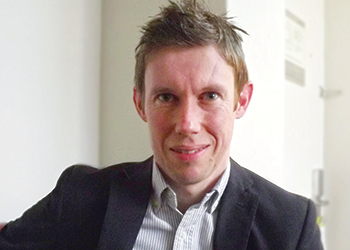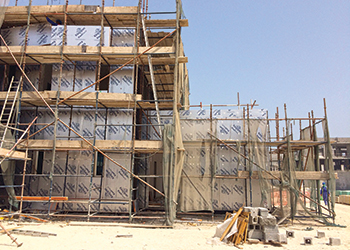Effective insulation key to environmental gains
01 June 2016
ANDREW PACK, global technical support manager, Kingspan Insulation, says improvement in U-value specifications for buildings can deliver considerable returns on investment (ROIs) and reduce carbon emissions.
With the national electricity demand of the UAE and Saudi Arabia growing between seven and nine per cent annually, it isn’t surprising that Saudi Arabia as well as other countries across the Gulf have committed to reducing their annual consumption and emissions.
This commitment is to reduce emissions by 130 million tonnes of carbon dioxide equivalents (mtCO2eq) and electricity intensity by 30 per cent before 2030. Within Saudi Arabia alone, 70 per cent of electricity demand for buildings is for cooling. So, to fulfil the commitment, it’s essential that countries consider a holistic approach to reducing carbon emissions and energy demand and this includes a more efficient building stock.
By modelling buildings within environmental profiles across the Gulf, global management, engineering and development consultancy Mott MacDonald developed a research programme to discover the impact improving U-values over and above that specified by current local regulations, such as those prescribed in Saudi Arabian Standards Organisation (Saso), Dubai Green Building Code and Kahramaa (for Qatar). The consultancy reviewed whether the energy demand and carbon emissions would decrease and, furthermore, if the energy demand decreases sufficient to provide the building owner a return on investment (ROI). The results were overwhelming.
The study
For its study, Mott MacDonald modelled six buildings, representative of common building types across the Gulf – villa, low-rise residential, low-rise commercial, high-rise residential, high-rise commercial and hotel. The study looks at four different constructions within the six buildings. Two build-ups within the walls – one using an insulated cladding façade and the other using an external insulation finishing system (EIFS) – one roof construction comprising a concrete deck and one floor construction comprising a concrete slab were considered.
The firm then compared the effects of improving U-value specifications, by using additional insulation, in the roof, floor and external walls of the buildings. The model considered a wide range of physical, environmental and financial building characteristics such as building size and use, energy consumption and cost, elemental cost and regional environmental profiles.
 |
Pack ... insulation is a worthwhile investment. |
For each of the 1,744 scenarios, an energy consumption comparison was made between the regional baseline U-value specification and an improved U-value specification. The construction cost for each build-up was entered into the model, and the ROI for the improved U-value was then calculated by dividing the added cost of the insulation by the value of the energy savings over the life time of the building.
As would be expected, the study showed an initial rise in projects costs of between 0.01 per cent and 3.23 per cent of the overall project developments. However despite these increases, the calculated results for the modelled buildings showed that an overwhelming ROI could be achieved by improving the U-value specification. In total, almost 100 per cent of the calculations showed energy and carbon emissions savings, additionally up to 57 per cent of a building’s calculations showed an ROI of over 100 per cent, and more than one in seven of the total calculations displayed an ROI exceeding 200 per cent, with returns of over 6,500 per cent being identified in some instances.
The models
One iteration Mott MacDonald looked at was a new, medium-specification, six-storey residential block, located in Riyadh, Saudi Arabia. The low-rise residential building is constructed using reinforced concrete, infilled with concrete blockwork walls, which utilise an EIFS. The floor is constructed using a concrete slab insulated above and the roof is constructed using a concrete deck insulated above.
The energy use and corresponding carbon emissions of the 5,711-sq-m building was calculated for the baseline U-value specification required in Riyadh of 0.31 W per sq m K, 1.825 W per sq m K and 0.53 W per sq m K in the roof, floor and external wall, respectively. The energy use and carbon emissions were then calculated for the building after improving the U-values to 0.25 W per sq m K, 0.54 W per sq m K and 0.29 W per sq m K.
The improved U-value specifications resulted in an energy saving of 13,463 kWh per year and a carbon emission saving of 9,788 kgCO2 per year. The results also represented an ROI of 335 per cent on the cost of the additional insulation, with only a 0.20 per cent uplift in the overall initial development costs.
Across the Gulf
The rest of Mott MacDonald’s study showed the strongest financial returns were seen in residential buildings. However, the study also revealed significant returns in commercial buildings. For example, the ROI for improving U-value specifications in a hotel, resulted in ROIs of up to 445 per cent in Dubai (UAE), 840 per cent in Muscat (Oman), and 136 per cent in Doha (Qatar) and showed carbon emissions savings could be made in all locations.
Raising the initial construction cost of a project is never an easy decision for specifiers, however, as Mott MacDonald’s study shows, improving the U-value specifications can deliver a considerable ROI for all buildings, regardless of the building type or location, and will reduce carbon emissions and energy demand in every occasion, making it a well worthwhile investment.
- Masdar City green footprint to expand
- Hilton Garden Inn Leeds with green credentials
- Effective insulation key to environmental gains
- Kingspan uses blowing agent with zero ODP
- Unigulf promotes Oriform’s benefits
- Bahrain working on 40 ‘green’ building projects
- Magic Dow fluid captures solar energy



